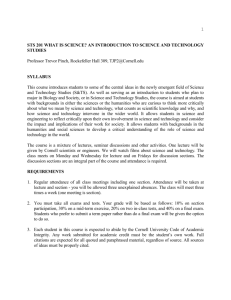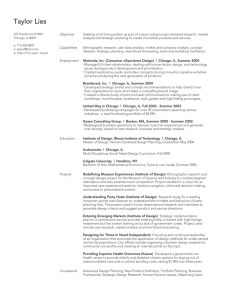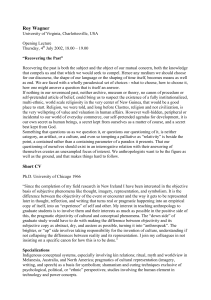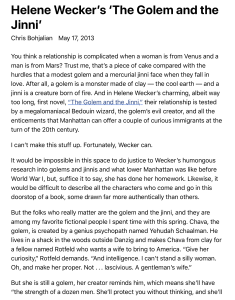Harry Collins: Main Books List
advertisement
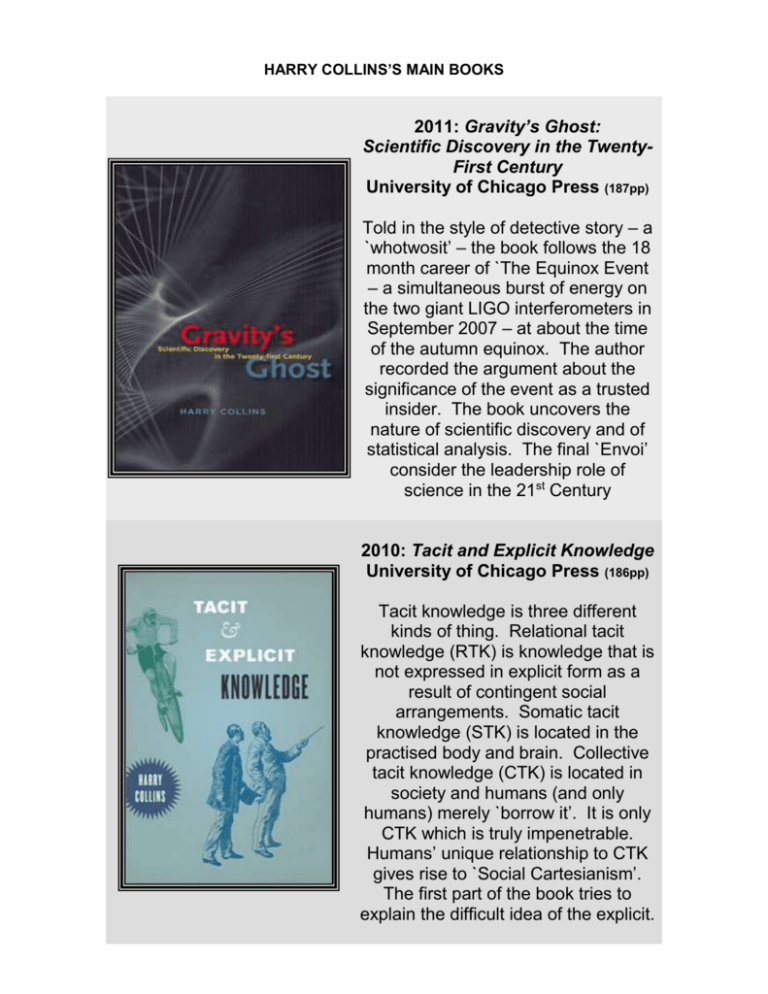
HARRY COLLINS’S MAIN BOOKS 2011: Gravity’s Ghost: Scientific Discovery in the TwentyFirst Century University of Chicago Press (187pp) Told in the style of detective story – a `whotwosit’ – the book follows the 18 month career of `The Equinox Event – a simultaneous burst of energy on the two giant LIGO interferometers in September 2007 – at about the time of the autumn equinox. The author recorded the argument about the significance of the event as a trusted insider. The book uncovers the nature of scientific discovery and of statistical analysis. The final `Envoi’ consider the leadership role of science in the 21st Century 2010: Tacit and Explicit Knowledge University of Chicago Press (186pp) Tacit knowledge is three different kinds of thing. Relational tacit knowledge (RTK) is knowledge that is not expressed in explicit form as a result of contingent social arrangements. Somatic tacit knowledge (STK) is located in the practised body and brain. Collective tacit knowledge (CTK) is located in society and humans (and only humans) merely `borrow it’. It is only CTK which is truly impenetrable. Humans’ unique relationship to CTK gives rise to `Social Cartesianism’. The first part of the book tries to explain the difficult idea of the explicit. 2007: Rethinking Expertise (with Robert Evans) University of Chicago Press (159pp) Ideas first set out in Collins and Evans’s 2002 paper, `The Third Wave of Science Studies’ are consolidated. The `Periodic Table of Expertises’ is meant to be an exhaustive listing of ways of being an expert in a technological domain; `meta-expertises’ are used to judge between experts. The idea of interactional expertise is developed and explored along with the Imitation Game for testing it. The final chapter concerns demarcation of science and a new criterion, the locus of legitimate interpretation, is proposed. 2007: Case Studies of Expertise and Experience Special Issue of SHPS v38 no 4 pps 614-760 Contains ten papers and an Introduction setting out the new programme. Papers cover: interdisciplinarity; interactional expertise and management; use of mathematics in physics; economic forecasting; communication among biologists; technology in tuna fishing; mirror neurons and interactional expertise; South African AIDS prevention policy; and the philosophical consequences of the idea of interactional expertise on the philosophy of embodiment. 2005: Dr Golem: How to think about medicine (with Trevor Pinch) University of Chicago Press (246pp) Dr Golem, continues the tradition of Introduction, Conclusion and case studies. These cover the placebo effect and double-blind testing; bogus doctors; alternative therapies; AIDS treatments; tonsillitis fashions, fashionable diseases, effectiveness of CPR and vaccination, where the authors argue violently opposed views with regard to parental responsibility. The overall conclusion is that individuals might find solace in alternative therapies but a state’s duty is to recognised medical science 2004: Gravity’s Shadow: The Search for Gravitational Waves University of Chicago Press (870pp) A sociological history of the search for gravitational waves from the beginning in the 1950s up to around 2003. The book is part-based on the author’s trusted intense involvement with the field from 1994 onwards along with extensive interviews carried out in the 1970s. The controversy over Joseph Weber’s early findings are dealt with at length as are subsequent disputed claims and the international tensions. The change from small science to big science is extensively covered and the associated traumas are explained 2001: The One Culture? A conversation about science (edited with Jay Labinger) University of Chicago Press (329pp) Presents a three-round debate between those at the frontier of science studies and scientists or `science warriors’. Contributors are Collins, Dear, Gregory & Miller, Lynch, Pinch, and Shapin on the science studies side and, Mermin, Saulson, Sokal & Bricmont, Weinberg and Wilson & Barsky on the other. The arguers mostly come to agree that they had more in common than they thought. This may have been the book that did most to end the `science wars’. 1998: The Shape of Actions: What humans and machines can do (with Martin Kusch) MIT Press (212pp) `Polimorphic’ and `mimeomorphic’ actions are the new names for `regular actions’ and `machine-like actions’ first described in Artificial Experts. In the former there is no mapping between intention and visible behaviour whereas in the latter there is. A complex typology of actions is developed to support the main distinction. Worked examples include writing and the operation of air pumps. The two kinds of action are central to understanding how humans and non-humans relate. 1998: The Golem at Large: What you should know about technology (with Trevor Pinch) Cambridge University Press (163pp) The book applies the successful Golem model to technology, covering the success of the Patriot missile, the Challenger explosion, testing of nuclear fuel flasks and safe aviation fuel, the origins of oil, economic forecasting, the dispute about how to limit the effect of Chernobyl on UK sheep farming and the dispute about AIDS treatment in San Francisco. As with the other Golem books, the authors contribute some original chapters and base others on existing material. 1993/1998: The Golem: What you should know about science (with Trevor Pinch) Cambridge University Press (192pp) This well-known book featured heavily in the `science wars’, particularly in respect of the chapter on the foundation of the theory of relativity. The debate gave rise to the new Afterword published in the 1998 edition. The seven case studies of scientific controversy cover chemical transfer of memory, relativity (Michelson and Eddington), cold fusion, the germ theory, gravitational waves, the sex life of lizards, and solar neutrinos. There is a forthright Introduction and Conclusion. 1990: Artificial Experts: Social Knowledge and Intelligent Machines MIT Press (266pp – now print on demand) A critique of artificial intelligence and expert systems based on SSK (sociology of scientific knowledge). A new question is how, given the social model of knowledge, there can be machines such as pocket calculators. The solution is to introduce `machinelike actions’, where humans try to act like machines. These contrast with `regular actions’ which are dependent on social context. The treatment departs from earlier critiques of AI (eg Dreyfus) in emphasising the social, not embodied, nature of knowledge. 1985/1992: Changing Order: Replication and Induction in Scientific Practice University of Chicago Press (199pp) Papers written in 1974 &1975 mark the start of empirical SSK. The book develops these and introduces the idea of the `experimenter’s regress’ which shows why it impossible to prove a disputed result solely by repeating experiments. The case studies of the TEA-laser and gravitational wave detection are compared with an area of paranormal science. The first two chapters show how the sociological approach is rooted in the problem of induction and offers a `sociological solution’ to it. 1982: Frames of Meaning: The social construction of extraordinary science (with Trevor Pinch) Routledge (210pp – now print on demand) A study of the investigation of children who claimed to be able to bend spoons paranormally like Uri Geller. The relationship of this `extraordinary’ science to `normal science’ is analysed in terms of the Kuhnian idea of incommensurability. The results of a study of children were reported in Nature and the way this was received, is analysed. Interviews are conducted with scientists and the role of quantum theory in PSI theory is described.


